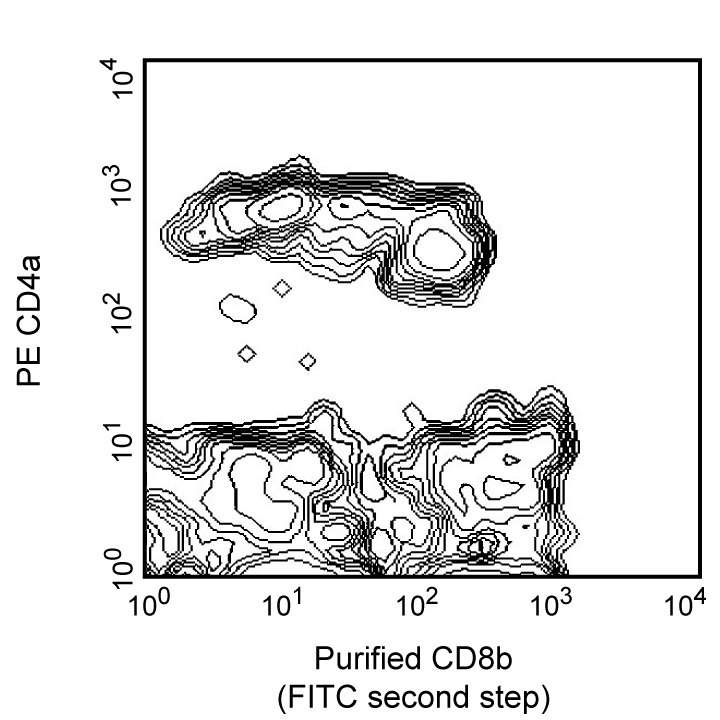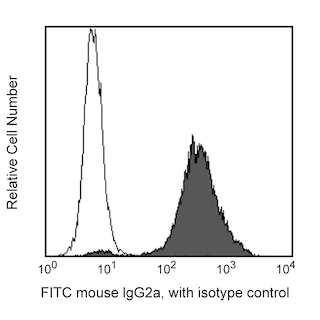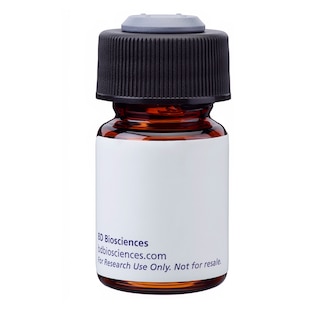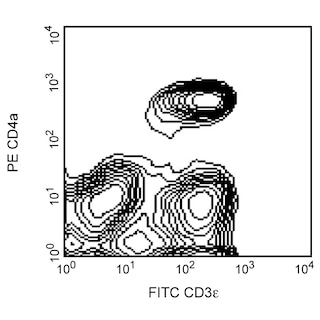Old Browser
Looks like you're visiting us from {countryName}.
Would you like to stay on the current country site or be switched to your country?




CD8 expression on peripheral blood lymphocytes. Yorkshire pig whole blood was stained with purified 295/33-25 monoclonal antibody followed by FITC-conjugated anti-mouse IgG2a mAb R19-15 (Cat. No. 553390), then PE-conjugated mAb 74-12-4 (anti-pig CD4a, Cat. No. 559586). Erythrocytes were lysed (BD PharmLyse™, Cat. No. 555899), non-viable leukocytes were excluded by staining with 7-AAD (BD Via-Probe™, Cat. No. 555816/555815), and lymphocytes were gated according to scatter profile. Flow cytometry was performed on a BD FACSCalibur™ Flow Cytometry System.


BD Pharmingen™ Purified Mouse Anti-Pig CD8b

규제 상태 범례
Becton, Dickinson and Company의 명시적인 서면 승인 없이는 사용 하실 수 없습니다.
준비 및 보관
제품 고시
- Since applications vary, each investigator should titrate the reagent to obtain optimal results.
- Please refer to www.bdbiosciences.com/us/s/resources for technical protocols.
- Sodium azide is a reversible inhibitor of oxidative metabolism; therefore, antibody preparations containing this preservative agent must not be used in cell cultures nor injected into animals. Sodium azide may be removed by washing stained cells or plate-bound antibody or dialyzing soluble antibody in sodium azide-free buffer. Since endotoxin may also affect the results of functional studies, we recommend the NA/LE (No Azide/Low Endotoxin) antibody format, if available, for in vitro and in vivo use.
- Caution: Sodium azide yields highly toxic hydrazoic acid under acidic conditions. Dilute azide compounds in running water before discarding to avoid accumulation of potentially explosive deposits in plumbing.
관련 제품




The 295/33-25 monoclonal antibody specifically binds to an epitope on the CD8α chain, a 35 kDa antigen expressed on thymocytes, peripheral T lymphocytes, and NK cells. The CD8 molecule can exist as a 70 kDa homodimer, composed of α chains, or heterodimer, composed of an α and a β chain. Two peripheral CD8+ T-cell populations can be distinguished in the pig: CD8-bright CD4-negative CTL effectors/precursors and CD8-dull CD4-positive T-helper lymphocytes. Pig NK cells express CD8 (dull staining), CD2, MHC class II, LFA-1, and asialo-GM1; but not CD3, CD4, CD5, or CD6. mAb 295/33-25 was clustered as anti-CD8b at the First International Swine CD workshop.
개발 참고 자료 (10)
-
Dato ME, Kim YB. Characterization and utilization of a monoclonal antibody inhibiting porcine natural killer cell activity for isolation of natural killer and killer cells. J Immunol. 1990; 144(11):4452-4462. (Biology). 참조 보기
-
Jonjic N, Jonjic S, Saalmuller A, Rukavina D, Koszinowski UH. Distribution of T-lymphocyte subsets in porcine lymphoid tissues. Immunology. 1987; 60(3):395-401. (Clone-specific: Immunohistochemistry). 참조 보기
-
Jonjic S, Koszinowski UH. Monoclonal antibodies reactive with swine lymphocytes. I. Antibodies to membrane structures that define the cytolytic T lymphocyte subset in the swine. J Immunol. 1984; 133(2):647-652. (Immunogen: Cytotoxicity, ELISA, Immunoprecipitation). 참조 보기
-
Pescovitz MD, Lowman MA, Sachs DH. Expression of T-cell associated antigens by porcine natural killer cells. Immunology. 1988; 65(2):267-271. (Biology). 참조 보기
-
Saalmuller A, Aasted B, Canals A, et al. Analyses of mAb reactive with porcine CD8. Vet Immunol Immunopathol. 1994; 43(1-3):249-254. (Clone-specific: Immunoprecipitation). 참조 보기
-
Saalmuller A, Hirt W, Maurer S, Weiland E. Discrimination between two subsets of porcine CD8+ cytolytic T lymphocytes by the expression of CD5 antigen. Immunology. 1994; 81(4):578-583. (Biology). 참조 보기
-
Saalmuller A, Pauly T, Hohlich BJ, Pfaff E. Characterization of porcine T lymphocytes and their immune response against viral antigens. J Biotechnol. 1999; 73(2-3):223-233. (Biology). 참조 보기
-
Saalmuller A, Werner T, Fachinger V. T-helper cells from naive to committed. Vet Immunol Immunopathol. 2002; 87(3-4):137-145. (Biology). 참조 보기
-
Zuckermann FA, Pescovitz MD, Aasted B, et al. Report on the analyses of mAb reactive with porcine CD8 for the second international swine CD workshop. Vet Immunol Immunopathol. 1998; 60(3-4):291-303. (Biology). 참조 보기
-
Zuckermann FA. Extrathymic CD4/CD8 double positive T cells. Vet Immunol Immunopathol. 1999; 72(1-2):55-66. (Biology). 참조 보기
Please refer to Support Documents for Quality Certificates
Global - Refer to manufacturer's instructions for use and related User Manuals and Technical data sheets before using this products as described
Comparisons, where applicable, are made against older BD Technology, manual methods or are general performance claims. Comparisons are not made against non-BD technologies, unless otherwise noted.
For Research Use Only. Not for use in diagnostic or therapeutic procedures.
Report a Site Issue
This form is intended to help us improve our website experience. For other support, please visit our Contact Us page.